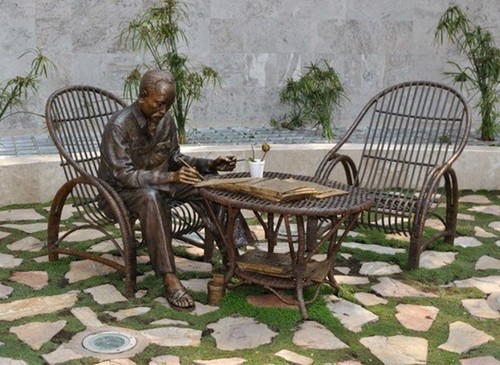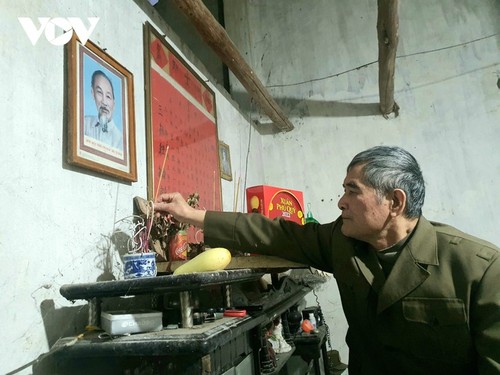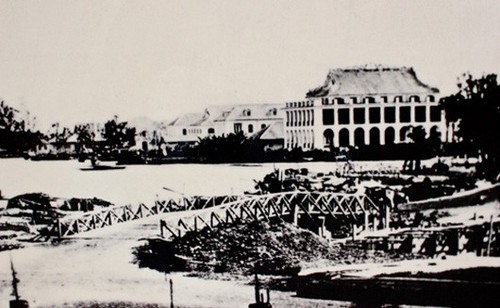
President Ho Chi Minh’s legacy honored and promoted internationally (photo: baotanglichsuquocgia.vn)
|
B: Mr. Bosu told us that the seminar was focused on fostering India-Vietnam relations. He wrote: “It was held as part of the celebration of the 50th anniversary of the establishment of Vietnam-India diplomatic relations and the 132nd birth anniversary of the great President Ho Chi Minh by the Vietnamese Embassy in India and the Indo-Vietnam Solidarity Committee.”
A: Robi said the seminar recalled Uncle Ho’s life and the career that made him a legendary figure. He expressed his hope for stronger ties between the two countries.
B: Rabi was one of the winners of VOV’s 2020 Contest “What do you know about Vietnam?” Once again, congratulations, Mr. Bosu. We hope to continue to receive your feedback on our English broadcasts and hope to see you in Vietnam some day.
A: This week, many other listeners have sent us greetings on the 132nd birth anniversary of President Ho Chi Minh. In Vietnam and overseas, Vietnamese people have organized several activities to celebrate the birthday.
 A local man in Pac Po hamlet burns incense to pay gratitude toward ancestors and Uncle Ho. A local man in Pac Po hamlet burns incense to pay gratitude toward ancestors and Uncle Ho. |
B: Many listeners expressed an interest in our story about Ho Chi Minh’s return to Cao Bang province.
A: On January 28, 1941, Ho Chi Minh returned to Vietnam after a 30-year journey to seek national salvation. He arrived in Pac Bo in Ha Quang district, Cao Bang province. Since that time, the image of Ho Chi Minh, locally called “Ong Ke” as a loving tribute, has been imprinted in the hearts of the people of Pac Bo hamlet.
B: In the Tay language, "Ong Ke" means "old man", an informal and intimate way to refer respectfully to an elderly man.
A: At that time, Uncle Ho or “Ong Ke” took care of everyone. He bathed small children, helped the elderly, taught young people to read, taught the locals how to grow vegetables and increase their production. Ong Ke was considered a son of the Pac Bo mountain forest.
B: Educated by “Ong Ke”, the people of Pac Bo awakened to the ideas of the revolution. After a time, revolutionary organizations of farmers, young people, and children were established in Hà Quảng district.
A: Like a spark lit by Uncle Ho in Pac Bo, the revolutionary movement spread throughout the nation, and flared into a revolutionary storm to liberate the nation from the yoke of miserable slavery.
B: Discussing President Ho Chi Minh’s journey for national salvation, there’s one place we must mention: Nha Rong Wharf.
 Nha Rong Wharf in Saigon (now Ho Chi Minh city) (Photo: archive) Nha Rong Wharf in Saigon (now Ho Chi Minh city) (Photo: archive) |
A: Nha Rong Wharf in Ho Chi Minh City was the place where Ho Chi Minh embarked in 1911 to seek national salvation. Now this historical relic attracts crowds of visitors, who come to learn about Uncle Ho’s life, career, patriotism, and historic journey.
B: Nha Rong Wharf was built in 1863 by the French as the headquarters of the Five Star Vessel Corporation. The building at the junction of the Saigon River and the Ben Nghe River has a Western-style architecture but also has two dragons on the roof, a signature decoration of Vietnam’s pagodas and temples.
A: A statue of Ho Chi Minh when he was young stands in front of the wharf, looking to the Sai Gon river, to remind people of the patriotic young man Nguyen Tat Thanh who left the wharf on the French ship Admiral Latouche Treville to begin his quest for salvation. With a strong determination, he once said: “Freedom for my fellow countrymen and homeland is all I want or understand”.
 Latouche Treville ship, where young patriot Nguyen Tat Thanh (who later became President Ho Chi Minh) embarked on a journey for national liberation (Photo: archive) Latouche Treville ship, where young patriot Nguyen Tat Thanh (who later became President Ho Chi Minh) embarked on a journey for national liberation (Photo: archive) |
B: Nha Rong Wharf’s official name is now Ho Chi Minh Museum – Ho Chi Minh City branch. From three initial rooms, each 250 square meters in area, the museum has grown to include exhibition rooms and two store rooms. Six of the nine exhibition rooms have permanent exhibits of documents, photos, and other items that played a part in Ho Chi Minh’s life and revolutionary career. The other three exhibition rooms are used for temporary exhibits.
 Nha Rong Wharf in Ho Chi Minh City Nha Rong Wharf in Ho Chi Minh City |
A: Since 1995, the Museum has hosted a great number of events, some in outlying districts, and at remote venues, including exhibits, symposiums, contests, publication launches, and film screenings.
B: Here’s a letter from Siddhartha Bhattacharjee who reported listening to our broadcast from 16:00 to 16:30 UTC on the frequency of 7220 khz and said the signal was good with SIO of 444.
A: In his email to VOV this week, he sent us greetings on the occasion of Buddha’s birthday, which falls on the full moon of the 4th lunar month. He wrote: “May Lord Buddha remove the obstacles in our lives. Happy Buddha’s birthday to you and your loved ones”
B: Millions of Buddhists in Vietnam will celebrate Vesak Day 2022 on Sunday. The festival commemorates the birth, enlightenment, and death of Lord Buddha.
A: On 15 December, 1999, the United Nations General Assembly adopted a resolution entitled 'International recognition of the Day of Vesak at United Nations Headquarters and other United Nations offices'.
B: The resolution recognizes the Day of Vesak to acknowledge the contributions that Lord Buddha and Buddhism have made for over two and a half millennia.
A: This week, we have received more than 300 letters and emails from listeners around the world. Many of them expressed an interest in Vietnam’s hosting of the 31st Southeast Asian Games this month.
B: In our news stories, we have been reporting on the sports events at SEA Games 31. We’re very happy to share with you that as of May 17, Vietnam stands first in the SEA Games medal tally with 105 gold medals, followed by Thailand with 43 gold medals and the Philippines with 34.
 The performance ends the closing ceremony of SEA Games 31. (Photo: VNA) The performance ends the closing ceremony of SEA Games 31. (Photo: VNA) |
A: SEA Games 31 is giving localities across Vietnam an opportunity to promote their tourism.
B: The visiting athletes have been offered tours to explore local landscapes, culture and cuisine.
A: Travel companies in Hanoi have organised 28 tours for coaches, athletes and spectators attending the 31st Southeast Asian Games, according to the municipal Department of Tourism.
B: The tours focus on the cultural, historical and architectural values of Hanoi, along with scenic spots and ancient villages on the city’s outskirts.
A: Some tours visit Ho Chi Minh Mausoleum, the Ho Chi Minh Museum, the Temple of Literature, Hoan Kiem Lake, Bat Trang pottery village, Co Loa Citadel, and eating spots in Hanoi’s Old Quarter.
B: Tourism companies are also offering trips to Ninh Binh, Sa Pa and Mai Chau. The Hanoi Transport Corporation is arranging free tours on double-decker buses that run every hour between 9am and 5pm every day for all athletes, coaches and reporters.
A: The buses carry passengers to 25 streets with 15 stops at key tourist destinations. Each bus is equipped with audio guides in 10 languages.
A: Ratan Kumar Paul of India reported listening to our Letter Box on April 27th on the frequency of 7220 Khz from 16 to 16:30 UTC using a telescope antenna with a 50-foot wire. He is a regular listener to VOV and has a particular interest in our Letter Box segment.
B: Mr. Sreenivasa Raju of India wrote: “I listened your English service via shortwave on a Sony ICF SW 35 radio with a 15-meter wire antenna. I enjoyed your beautiful music. Thank you VOV.”
A: Thank you all for tuning in to VOV and for sending us your feedback. We hope to receive more comments and reception reports from you all.